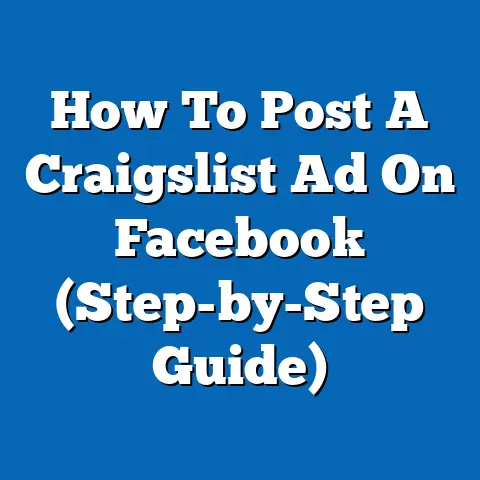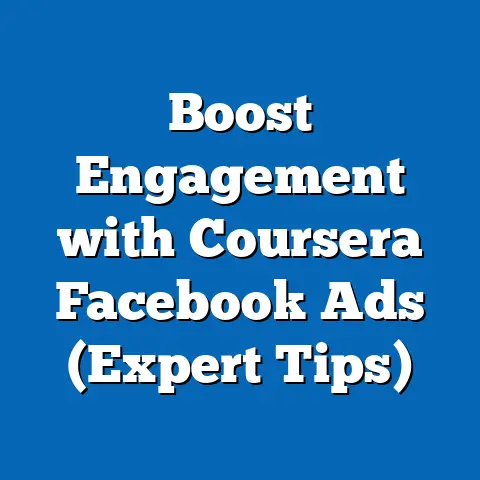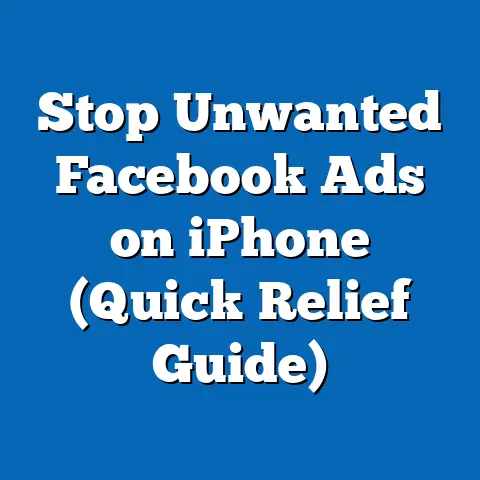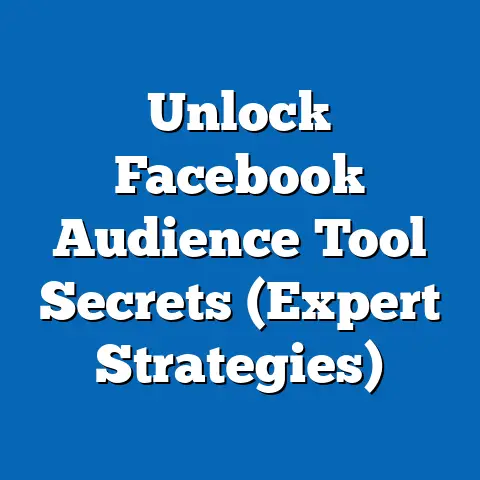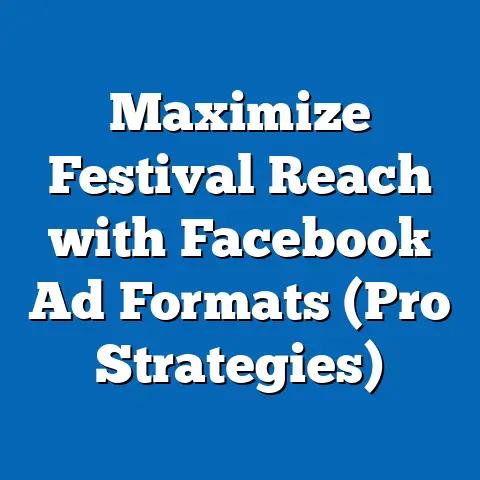Master Facebook Administration (Boost Engagement Strategies)
Have you ever felt like you’re shouting into the void on Facebook? You meticulously craft a post, hit “publish,” and… crickets. It’s a frustrating reality for many businesses today. Organic reach is dwindling, and the competition for attention is fiercer than ever. Studies show that organic reach for Facebook pages has been steadily declining, with some estimates suggesting it’s below 2%. That means less than 2% of your followers might actually see your content without a paid boost.
Why are your posts getting fewer likes and shares? Have you noticed a decline in interactions despite your best efforts? The truth is, simply having a presence on Facebook isn’t enough anymore. You need to master Facebook administration and implement effective engagement strategies to cut through the noise and connect with your audience.
In this guide, I’m going to share my experiences and insights from years of managing Facebook pages for businesses of all sizes. I’ll break down the algorithm, reveal the secrets to crafting engaging content, and show you how to leverage Facebook’s features to foster a thriving community. Let’s dive in!
1: Understanding Facebook’s Algorithm
The Facebook algorithm is the gatekeeper to your audience’s newsfeeds. It’s a complex system that determines which content users see, and understanding how it works is crucial for boosting your engagement.
Overview of the Algorithm
At its core, the Facebook algorithm aims to show users content they’ll find most relevant and engaging. It analyzes thousands of factors to predict which posts will spark a user’s interest, including:
- Engagement: How many people are liking, commenting, sharing, and clicking on a post?
- Relevance: Is the content relevant to the user’s interests, based on their past behavior?
- Recency: How recently was the post published? Newer posts tend to get higher priority.
- Relationship: Does the user frequently interact with the page or poster?
- Content Type: Does the user prefer videos, photos, or links?
The algorithm uses these signals to assign a “relevancy score” to each post for each user. The higher the score, the more likely the post is to appear in that user’s newsfeed.
My Experience: I remember when Facebook started prioritizing “meaningful interactions” – posts that sparked conversations between friends and family. Suddenly, the generic promotional posts that used to work were falling flat. I had to completely rethink my content strategy to focus on creating content that encouraged dialogue and connection.
Impact on Business Pages
The algorithm’s preference for meaningful interactions has a significant impact on business pages. It means that simply posting promotional content or sharing links isn’t enough to reach your audience. You need to create content that encourages people to engage and interact with each other.
Here’s how understanding the algorithm can help you:
- Prioritize Engaging Content: Focus on creating content that sparks conversations, encourages shares, and generates meaningful interactions.
- Post at Optimal Times: Use Facebook Insights to identify when your audience is most active and schedule your posts accordingly.
- Target Your Audience: Use Facebook’s targeting options to ensure your content reaches the people who are most likely to be interested in it.
- Encourage Employee Advocacy: Encourage your employees to like, comment, and share your posts to increase their reach and engagement.
Takeaway: The Facebook algorithm is constantly evolving, so it’s important to stay up-to-date on the latest changes and adjust your strategy accordingly. Focus on creating high-quality, engaging content that resonates with your audience, and you’ll be well on your way to boosting your Facebook engagement.
2: Crafting Engaging Content
Now that you understand the algorithm, let’s talk about the heart of your Facebook strategy: the content itself. Creating truly engaging content is an art and a science, requiring a blend of creativity, data analysis, and understanding your audience.
Types of Content That Spark Engagement
Not all content is created equal. Certain types of content tend to perform better on Facebook, generating higher engagement rates and reaching a wider audience. Here are a few examples:
- Videos: Videos are incredibly engaging, especially short, visually appealing videos with captions. According to HubSpot, videos generate 1200% more shares than text and images combined.
- Live Videos: Facebook Live allows you to connect with your audience in real-time, fostering a sense of community and authenticity.
- Questions: Asking questions is a simple but effective way to encourage interaction. Ask open-ended questions that invite people to share their thoughts and opinions.
- Polls: Polls are a fun and interactive way to gather feedback and engage your audience.
- User-Generated Content (UGC): Sharing content created by your fans and customers is a great way to build community and show appreciation.
- Behind-the-Scenes Content: Give your audience a glimpse into your company culture and operations. People love to see the human side of your business.
Real-World Example: GoPro is a master of user-generated content. They regularly feature videos and photos taken by their customers using GoPro cameras, showcasing the incredible adventures and experiences their products enable. This not only generates high engagement but also builds brand loyalty and inspires others to share their own content.
The Power of Storytelling
Beyond the specific content type, the way you present your content is crucial. Storytelling is a powerful tool for connecting with your audience on an emotional level.
Here’s how you can incorporate storytelling into your Facebook posts:
- Share Relatable Stories: Tell stories that resonate with your audience’s experiences, values, and aspirations.
- Focus on the Human Element: Highlight the people behind your brand – your employees, customers, and partners.
- Use Vivid Language: Paint a picture with your words, using descriptive language and sensory details.
- Create a Narrative Arc: Structure your stories with a beginning, middle, and end to keep your audience engaged.
- Connect with Emotions: Tap into your audience’s emotions – their hopes, fears, joys, and frustrations.
My Experience: I once worked with a local bakery that was struggling to gain traction on Facebook. We decided to focus on telling the story of the bakery’s founder, a passionate baker who had overcome numerous challenges to pursue her dream. We shared her story through a series of posts, highlighting her dedication, resilience, and love for baking. The response was incredible. People connected with her story on a personal level, and the bakery’s engagement skyrocketed.
Takeaway: Don’t just sell your products or services on Facebook. Tell stories that connect with your audience on an emotional level. Share your brand’s values, highlight your people, and create a narrative that resonates with their lives.
3: Leveraging Facebook Features for Engagement
Facebook offers a range of features designed to boost engagement. Mastering these features is key to maximizing your impact on the platform.
Utilizing Facebook Live and Stories
Facebook Live and Stories are powerful tools for real-time engagement and interaction with your followers. They offer a more authentic and personal way to connect with your audience than traditional posts.
Facebook Live:
- Real-Time Interaction: Live videos allow you to interact with your audience in real-time, answering questions, responding to comments, and fostering a sense of community.
- Increased Visibility: Facebook often gives priority to live videos in the newsfeed, increasing their visibility and reach.
- Diverse Content Options: You can use Facebook Live for a variety of purposes, including Q&A sessions, product demos, behind-the-scenes tours, and live events.
Tips for Creating Engaging Live Content:
- Promote Your Live Streams in Advance: Let your audience know when you’ll be going live and what you’ll be discussing.
- Choose a Compelling Topic: Focus on topics that are relevant to your audience’s interests and needs.
- Engage with Your Audience: Ask questions, respond to comments, and encourage participation.
- Keep It Concise: Aim for a live stream that’s between 15 and 30 minutes long.
- Promote the Replay: After your live stream ends, promote the replay on your page to reach those who missed it live.
Facebook Stories:
- Ephemeral Content: Stories disappear after 24 hours, creating a sense of urgency and encouraging people to watch them before they’re gone.
- Interactive Features: Stories offer a range of interactive features, such as polls, quizzes, and question stickers, that can boost engagement.
- Creative Options: You can use Stories to share photos, videos, text, and GIFs, allowing you to get creative with your content.
My Experience: I’ve seen businesses use Facebook Stories incredibly effectively to share daily deals, run quick polls, and give sneak peeks of upcoming products. The ephemeral nature of Stories encourages people to check them regularly, leading to increased engagement and brand awareness.
Creating and Managing Facebook Groups
Facebook Groups are a fantastic way to build a niche community around your brand. They provide a space for your fans and customers to connect with each other, share their experiences, and engage in meaningful conversations.
Advantages of Creating a Facebook Group:
- Deeper Connections: Groups allow you to foster deeper connections with your audience than traditional Facebook pages.
- Increased Engagement: Members of Facebook Groups tend to be more engaged and active than followers of Facebook pages.
- Valuable Feedback: Groups provide a valuable source of feedback and insights into your customers’ needs and preferences.
- Brand Advocacy: Group members can become passionate brand advocates, spreading the word about your business to their friends and family.
Tips for Fostering Engagement in Your Facebook Group:
- Define a Clear Purpose: Establish a clear purpose for your group and communicate it to your members.
- Create Engaging Content: Share content that is relevant to your group’s purpose and encourages discussion.
- Moderate the Group: Actively moderate the group to ensure that it remains a positive and productive space.
- Encourage Member Interaction: Encourage members to share their own content, ask questions, and connect with each other.
- Run Contests and Giveaways: Contests and giveaways are a great way to boost engagement and reward your loyal members.
Takeaway: Facebook Live, Stories, and Groups offer powerful ways to connect with your audience on a deeper level and foster a thriving community around your brand. Experiment with these features and find the ones that work best for your business.
4: Engagement through Interactivity
Engagement isn’t a one-way street. It requires active participation from your audience. You need to create posts that encourage them to interact, share their thoughts, and connect with each other.
Encouraging User Interaction
Here are some strategies for creating posts that naturally encourage user interaction:
- Ask Questions: As mentioned earlier, asking questions is a simple but effective way to spark conversation. Ask open-ended questions that invite people to share their thoughts and opinions.
- Run Contests and Giveaways: Contests and giveaways are a great way to generate excitement and encourage participation.
- Use Call-to-Action Phrases: Use clear and concise call-to-action phrases that tell people what you want them to do, such as “Like this post if you agree,” “Share this with a friend,” or “Comment below with your favorite [product].”
- Create Fill-in-the-Blank Posts: Fill-in-the-blank posts are a fun and interactive way to encourage participation. For example, “My favorite thing about [product] is ______.”
- Share Quizzes and Polls: Quizzes and polls are a fun and engaging way to gather feedback and learn more about your audience.
Example: A local bookstore might post: “What’s the best book you’ve read this year? Tell us in the comments!” This simple question invites interaction and sparks conversation among book lovers.
Responding to Comments and Messages
Responding to comments and messages is crucial for building relationships with your audience and fostering a sense of community.
- Timely Responses: Aim to respond to comments and messages as quickly as possible. This shows your audience that you value their input and are actively listening to their concerns.
- Personalized Responses: Avoid generic responses. Take the time to personalize your replies and address each individual’s specific needs.
- Proactive Engagement: Don’t just wait for people to reach out to you. Proactively engage with your audience by liking their comments, responding to their posts, and participating in relevant conversations.
- Handle Negative Feedback Gracefully: Negative feedback is inevitable. Respond to it professionally and respectfully, and try to resolve the issue to the customer’s satisfaction.
My Experience: I’ve seen businesses turn negative comments into opportunities to build trust and loyalty. By responding quickly, acknowledging the issue, and offering a solution, they can demonstrate their commitment to customer satisfaction and turn a potentially negative situation into a positive one.
Takeaway: Engagement is a two-way street. Create posts that encourage interaction, respond to comments and messages promptly, and proactively engage with your audience to build relationships and foster a thriving community.
5: Analyzing Engagement Metrics
You can’t improve what you don’t measure. Tracking your engagement metrics is essential for understanding what’s working and what’s not, and for making informed decisions about your content strategy.
Key Metrics to Track
Here are some key metrics to track to evaluate your engagement strategies:
- Post Reach: The number of unique people who saw your post.
- Engagement Rate: The percentage of people who saw your post and interacted with it (liked, commented, shared, clicked).
- Likes: The number of likes your post received.
- Comments: The number of comments your post received.
- Shares: The number of times your post was shared.
- Click-Through Rate (CTR): The percentage of people who clicked on a link in your post.
- Video Views: The number of times your video was viewed.
- Website Traffic: The amount of traffic your Facebook posts are driving to your website.
You can find these metrics in Facebook Insights, a powerful analytics tool that provides detailed information about your page’s performance.
Using Insights for Improvement
Facebook Insights provides a wealth of data that you can use to improve your content strategy and boost your engagement.
Here’s how you can use Insights:
- Identify Your Top-Performing Posts: Analyze your past posts to identify which types of content generated the highest engagement.
- Understand Your Audience: Learn more about your audience’s demographics, interests, and behaviors.
- Determine Optimal Posting Times: Identify when your audience is most active and schedule your posts accordingly.
- Track Your Progress: Monitor your metrics over time to track your progress and identify areas for improvement.
- Experiment and Iterate: Use Insights to test different content formats, posting times, and targeting options, and iterate on your strategy based on the results.
Real-World Example: A restaurant noticed that their posts featuring photos of their daily specials generated significantly higher engagement than their other posts. They used this insight to adjust their content strategy, focusing on sharing more photos of their delicious dishes. As a result, their engagement increased significantly, and they saw a boost in reservations.
Takeaway: Facebook Insights is your secret weapon for understanding your audience, optimizing your content strategy, and boosting your engagement. Take the time to analyze your data and use it to make informed decisions about your Facebook marketing efforts.
6: Paid Advertising for Enhanced Engagement
While organic engagement is crucial, paid advertising can play a significant role in enhancing your reach and driving even more engagement.
Boosting Posts and Facebook Ads
Boosting posts allows you to extend the reach of your existing posts to a wider audience. Facebook Ads, on the other hand, allow you to create targeted ads that are shown to specific demographics, interests, and behaviors.
Boosting Posts:
- Increased Reach: Boosting posts can significantly increase the number of people who see your content, especially if you have a small or inactive audience.
- Targeted Audience: You can target your boosted posts to specific demographics, interests, and locations.
- Easy to Use: Boosting posts is a simple and straightforward process that can be done directly from your Facebook page.
Facebook Ads:
- Highly Targeted: Facebook Ads offer a wide range of targeting options, allowing you to reach a very specific audience.
- Diverse Ad Formats: You can choose from a variety of ad formats, including image ads, video ads, carousel ads, and collection ads.
- Measurable Results: Facebook Ads provide detailed analytics that allow you to track your performance and measure your ROI.
My Experience: I’ve found that a combination of organic and paid strategies is the most effective approach to Facebook marketing. I use organic content to build relationships and foster community, and I use paid advertising to extend my reach and drive specific business goals, such as generating leads or driving website traffic.
Creating Engaging Ad Content
Creating engaging ad content is essential for capturing attention and encouraging users to take action.
Here are some best practices for crafting compelling ad content:
- Use High-Quality Visuals: Use eye-catching images and videos that are relevant to your target audience.
- Write Compelling Copy: Write clear, concise, and persuasive copy that highlights the benefits of your product or service.
- Include a Clear Call to Action: Tell people what you want them to do, such as “Shop Now,” “Learn More,” or “Sign Up.”
- Target Your Audience: Ensure that your ad is shown to the people who are most likely to be interested in it.
- Test and Optimize: Test different ad formats, copy, and targeting options to see what works best.
Example: A clothing retailer might create a carousel ad featuring their new fall collection, with each image showcasing a different outfit. The ad copy would highlight the quality and style of the clothing, and the call to action would encourage users to “Shop Now” and browse the collection on their website.
Takeaway: Paid advertising can be a powerful tool for enhancing your reach and driving engagement on Facebook. Use it strategically to complement your organic efforts and achieve your specific business goals.
Conclusion: The Ongoing Journey of Engagement Mastery
Mastering Facebook administration and engagement strategies is an ongoing journey, not a destination. The platform is constantly evolving, and what works today may not work tomorrow. To succeed in the ever-changing landscape of social media marketing, you need to be adaptable, curious, and committed to continuous learning.
Here are some key takeaways to remember:
- Understand the Algorithm: Stay up-to-date on the latest changes to the Facebook algorithm and adjust your strategy accordingly.
- Create Engaging Content: Focus on creating high-quality, engaging content that resonates with your audience.
- Leverage Facebook Features: Master Facebook Live, Stories, and Groups to connect with your audience on a deeper level.
- Encourage Interactivity: Create posts that encourage interaction, respond to comments and messages promptly, and proactively engage with your audience.
- Analyze Your Metrics: Track your engagement metrics to understand what’s working and what’s not, and use Insights to improve your content strategy.
- Use Paid Advertising Strategically: Use paid advertising to extend your reach and drive specific business goals.
Don’t be afraid to experiment, test new strategies, and learn from your mistakes. The key to success on Facebook is to be adaptable, creative, and always focused on providing value to your audience.
Ready to take the first step towards mastering your Facebook engagement strategies? Start by analyzing your current performance in Facebook Insights and identifying areas for improvement. Then, experiment with different content formats, posting times, and targeting options to see what works best for your business. Remember, the journey of a thousand likes begins with a single post! Good luck!

